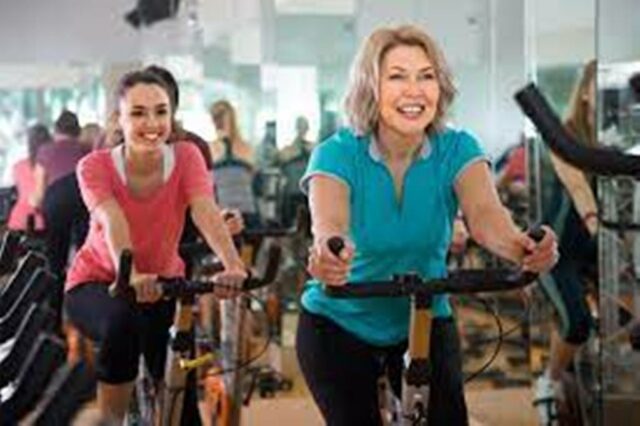It is scientifically proven that physical exercise is an essential tool to improve health and prevent chronic diseases. The excercise helps prevent pain and delay aging by considerably reducing the loss of muscle and bone mass and improving gross motor skills, balance and reflexes.In addition, it helps prevent metabolic diseases such as obesity or diabetes, among others.
The formula is very clear:
Exercise + healthy and balanced diet + rest = health and quality of life
Physical exercise as medicine
According to the WHO, lack of physical activity is one of the main risk factors for mortality from non-communicable diseases. People with an insufficient level of physical activity have a 20% to 30% higher risk of death compared to those who do achieve that ideal level of exercise.
Physical activity has been shown to have important health benefits:
- It helps prevent and control cardiovascular diseases, diabetes and various types of cancer.
- Helps prevent hypertension and maintain a healthy body weight.
- Improves mental health and reduces symptoms of stress, depression and anxiety.
- It improves cognitive processes, learning and delays aging.
- Contributes to healthy growth and development of young people.
- It combats the loss of muscle mass, thus preventing the appearance of ailments of the musculoskeletal system, such as back pain.
Although most of us are aware of the importance of physical exercise, globally, about 27.5% of adults and 81% of adolescents do not meet the 2010 WHO global recommendations on physical activity, moreover, there has been almost no improvement in the last 10 years.
There are also notable inequalities: data show that in almost all countries girls and women are less active, and that physical activity levels vary greatly between higher and lower economic groups and between countries and regions.
Main recommendations on physical activity
These are some of the main messages transmitted by the WHO in its recommendations:
- All people can benefit from increasing physical activity, so they should be physically active on a regular basis and limit sedentary lifestyle.
- Any amount of physical activity is preferable to none, and the more you get, the better.
- To improve health and well-being, the WHO recommends between 150 and 300 minutes of moderate aerobic physical activity per week or between 75 and 150 of vigorous aerobic physical activity in adults. In children and adolescents, on the other hand, an average of 60 minutes of moderate aerobic physical activity per day is recommended.

Muscle strengthening benefits everyone
Adults should also do muscle-strengthening activities two or more days a week, as it has additional health benefits. Older people (from65 years) should incorporate physical activities that prioritize balance and coordination, as well as muscle strengthening, to help prevent falls and improve their health.

Physical exercise prevents:
- The loss of muscle mass or sarcopenia: From the age of 25, the strength of the muscles progressively decreases if we do nothing to avoid it. After 50, a person can lose up to 2% of muscle mass per year.
The consequence? We become more prone to physical ailments such as back and lumbar pain. Physical exercise, and strength training in particular, helps us keep our bodies strong and healthy.
- Loss of bone mass or osteoporosis: It is vital to have healthy bones, and is essential for the prevention and treatment of osteoporosis. Bones, like muscles, are living tissues that respond to exercise and become stronger. In general, women and men who exercise regularly achieve higher bone density (the highest level of bone consistency and strength) than those who do not exercise.
Most people reach this peak bone density between 20 and 30 years old. Generally, from that age, bone density begins to decrease, to avoid this, women and men over 20 years of age can help prevent it by exercising frequently.
- Back pain: The main cause of back pain is the weakening of the muscles, particularly the deep extensors. This is the origin of 80% of pain-related problems. To prevent and improve discomfort, muscle strengthening through physical exercise is the most convenient.
Weak muscles mean less support and stabilization of the spine for the back, thus favoring the appearance of injuries and premature wear of the spine due to the bad posture.
An increasingly sedentary lifestyle with less physical activity will increase this situation. More than 70% of adults experience an episode of back pain at some point in their lives.
- Disease onset: Regular physical activity can reduce the risk of high blood pressure, coronary heart disease, stroke, diabetes, obesity, and several types of cancer, including breast and colon cancer. Also, it positively influences our mental health, reducing symptoms of anxiety, depression and stress.
- Premature aging: Although aging is a natural process of our body, physical exercise can help delay it and combat the problems that appear over the years. Many studies indicate that exercising regularly throughout our lives is undoubtedly the best medicine to slow down the aging process and keep us healthy. Some experts point out that it is essential to start exercising from the age of 25 to 30, when we begin to lose muscle mass.
It’s never too late to start. Exercise is the best medicine!
Don’t wait for tomorrow, start investing in yourself today.

